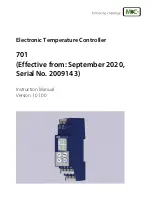
EAAM057608EN
GC250 Technical Manual 39
So to observe the denominations already provided in BoardPrg3 and
the reference diagrams.
5.7.1.1
Input T.12 ANALOGUE reference (Analogue Reference)
It is not a real measure input: it is used only together with the three inputs for resistive sensors.
Its purpose is to compensate for the lack of equipotential between electric earthing of the
device (terminal
T.01
GND
) and of the electric panel and electric earthing of the gen-set,
usually generated by the voltage drop on the connection cables; particularly, this happens
when the connections between electric panel and engine are long and when there is a power
flow in the battery minus and earthing connections, for example due to the presence of the
battery recharge device inside the electric panel.
The input measures the potential of the common ground point (negative) of the resistive
sensors, which for the sensors mounted on the engine is represented directly by the engine
itself or the chassis of the gen-set;
ATTENTION!:
T.12
must be connected with a predisposition of ground or with
a bolt on the engine. Do not connect T.12 to GND in the electric control panel or directly
to terminal T.01.
Note: this connection should be made using a dedicated wire having the shortest
possible length. Avoid to make the wire lies near high power and high voltage cable.
If the minus of one or several sensors is isolated from the engine or the gen-set chassis, for
example in the case of floats for fuel level measurement mounted on the plastic tanks or
electrically separated from the gen-set, you need to connect the
T.12
to the return of the
sensor and also to the negative electric mass of the engine or to the negative limit of the
starting battery.
The system is able to efficiently compensate for both positive and negative potentials, ranging
between -2.7VDC and +3.5VDC, with sensors resistance values of 100 ohm. The range of
compensation increases for lower resistor values and decreases for higher values of resistor,
being optimized for the resistor values of the sensors in normal operating conditions of the
system.
The measure of the voltage with respect to the GND terminal is displayed on page S.07, under
item T.12; the measuring range of the system, and therefore the value indicated, can be higher
than the one useful for compensation, mentioned above.
5.7.1.2
Input T.13, T.14, T.15 used as digital inputs
It is possible to singularly configure the three resistive analogue inputs as further digital inputs,
configuring them with function
“AIF.0100”
, see par. 5.7.2.
In order to activate the input, you need to connect it to the ground, and let it floating to
deactivate it. So these will be displayed in the configuration menu of the digital inputs and will
be manageable exactly as the other inputs; see par. 5.8. If one or more inputs are configured
as digital inputs, their statuses is displayed on page S.05 (0=input not active, 1=input active).
The inputs that are not configured as digital will be displayed with a hyphen.
5.7.2
Configuration and functions of analogue inputs
The analogue inputs can be used to acquire different predefined measures, or to acquire
generic sensors (therefore tailor made). Some measures can be only acquired by some inputs
(see the following chart).
As for the measures concerning the engine (pressure, temperature) with engine having digital
control unit, normally those data are directly acquired directly via CAN-BUS; sometimes it may
be necessary the use and the configuration of the resistive level sensor.
















































